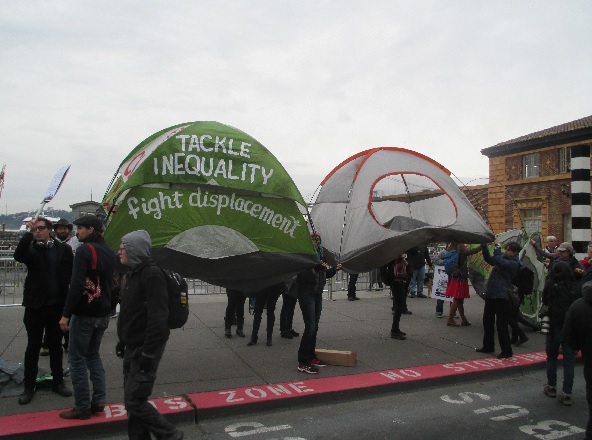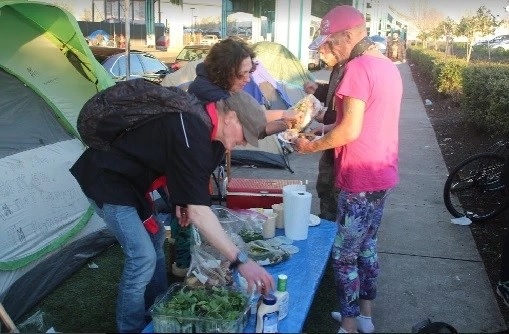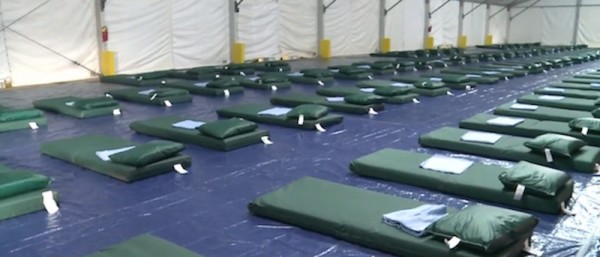There is so much misinformation about homeless people and the problem of homelessness in San Francisco that I almost don’t know where to start. But the news coverage of the homeless encampments, the Chron’s story on how much money the city spends on homeless services, and the ongoing attacks on tent cities suggest that a lot of us are missing the point.

Here are some of the biggest myths about homelessness in San Francisco:
- The city spends too much money on the problem.
That was kind of the gist of the Chron article. Although it made no explicit judgment, the headline — “SF spends record $241 million on homeless, can’t track results” suggests that there’s a lot of waste:
The $241 million is about equivalent to the annual budget for the Public Works Department, which cleans all the city’s streets, repairs its sidewalks, cleans up illegal dumping, maintains its trees, removes graffiti and more. That much money would pay for San Francisco’s entire library system for two years.
Yep: It’s a lot of money. It’s also about 2.8 percent of the city’s $8.6 billion budget.
But there’s a sizable flaw in the calculus: As Randy Shaw points out (in an article that has other problems, but gets this absolutely right), almost half the money that the Chron identifies as “homeless” spending is actually money spend on people who are in supportive housing. That’s housing money, not homeless money. Supportive housing isn’t cheap, but it’s cheaper than the alternatives.
If we counted all the money the city spends on affordable housing as money that keeps people from being homeless – and in many cases, that’s exactly what it does – the numbers would look even larger.
The city spends a lot on homeless services. Here’s why: We have created an enclave for the rich, and driven thousands out of their homes. We are a city of vast wealth. We have captured very little of that wealth for the public sector. Trickle-down economics was a sad, painful, devastating mistake when Ronald Reagan first made it the law of the land, and it’s just as bad in San Francisco today. The tech boom has enriched the few and impoverished the many.
Along the way, we have driven up the cost of land astronomically, making it harder and harder, and more and more expensive, for the city to buy or rent space for housing and services. The biggest under-reported story of the tech boom may be the impact on city agencies and nonprofits that serve the homeless and other vulnerable communities – they are getting driven out by rent hikes, too, or the city is forced to pay higher rates to keep them in place. It costs far more to build affordable housing today – because the land is so expensive, again because of the boom that Mayor Lee is so proud of.
Help us save local journalism!
Every tax-deductible donation helps us grow to cover the issues that mean the most to our community. Become a 48 Hills Hero and support the only daily progressive news source in the Bay Area.
There are, clearly, problems with tracking the money and the people, and better systems would help. But in the end, we are spending too little, not too much, on housing. (Some of the supes want a set-aside for Rec-Park, which I think is a dubious idea. But if we’re going in that direction, what if we set aside, say, $500 million a year for affordable housing? Then we could bond against that guaranteed income stream, and build about $10 billion worth of low-cost housing right now, which would house a substantial percentage of the currently homeless population.)
- The reason people are homeless is that they lack job skills or are lazy or are on drugs.
Actually, no. The main reason that so many people in San Francisco, and other cities like Los Angeles, are living on the streets is that the cost of housing over the past two decades has vastly exceeded the amount of income that people earn making minimum-wage jobs or bring in from modest pensions, disability, or welfare.
Before Reagan took office and destroyed the American safety net, and San Francisco decided to be the West Coast Manhattan, you could live on SSI or a low-wage job and still pay rent in this town. When that changed, people who were formerly housed became homeless.
There have always been people in US cities who have mental-health or substance-abuse issues, and there have always been people willing to work but lacking the skills to earn a six-figure income. Until fairly recently, most of those people could keep a roof over their heads. There wasn’t a lot of homelessness in American cities in the 1970s.
Now we have two intersecting economic disasters – the deep cuts in what we can generally call “welfare” payments and the radical dilution of the purchasing power of the minimum wage, and the explosive gentrification of San Francisco. Add in the federal government’s complete abandonment of cities (except when it comes to law enforcement) and it’s no wonder that there are tent cities all over town.
And hello: Are either of the Democratic candidates for president talking about urban housing issues, about a national crisis that ought to be on the top of the Washington agenda? If they are I’ve missed it. I remember Bill Clinton in 1992 promising to spend federal money to “put 100,000 more cops on the streets” in US cities. How about Hillary or Bernie pledging to build 100,000 new affordable housing units?
- San Francisco is a homeless magnet.
Oh yeah: People come here from all over because we’re such a great place to be homeless, right? As Jennifer Freidenbach of the Coalition on Homelessness wrote recently:
After all, we have such a wonderful safety net here. World class. I mean people are traveling miles and miles just to get here so they can wait in line with 3,000 other people just to get a meal. A shelter bed is a breeze, too, all you have to do is stand in line starting around 8:00 pm and stand there all night until 7 am, where you’ll likely get turned away, and where you then wait in line for still more hours for the chance to get a wristband that entitles you to wait for hours again to see if you won a bed for one night, and then stay in that bed until you have to leave first thing in the morning only to start the whole process over again.
Our warm embrace includes a beautiful place to live as well, we don’t just have a gorgeous bridge, we have rents that exceed a $20 an hour full time workers’ salary after taxes, and only 40,000 households on the waitlist for affordable housing. A waitlist that hasn’t opened for years.
The vast majority of the people who are homeless today used to be housed – in San Francisco. According to the city’s 2015 homeless count, 71 percent of the people on the streets were living in San Francisco when they lost their housing. That means seven out of ten homeless people used to be your neighbors – before the tech boom and the eviction epidemic. Those are, to a significant extent, people who are homeless not because they did anything wrong but because they aren’t rich enough to live in Ed Lee’s San Francisco.
Another 19 percent came from somewhere else in California, and ten percent from the rest of the country – but the last time anyone asked, back in 2009, whether they had come here for good services, only 1 percent said yes. The rest came here, in many cases, to leave abusive, homophobic, or repressive situations; they came here not for money but for tolerance.
Many of them – as many as 30 percent – are LGBT or disabled. Thousands are young people. Many have just aged out of foster care – and at 18, have no ability to earn the income that is required to rent an apartment, or even a room in a crowded flat.

- It’s unacceptable to let people live in tent cities
This is Sup. Scott Weiner’s big issue: He wants the tents cleared out, and says that it’s not humane or reasonable to have communities or homeless people living on the streets in what are basically campgrounds.
But there are no stable places for most of these thousands of homeless residents to go. And other cities, like Portland, have embraced the idea that maybe the crisis (NOT caused by the homeless people but by civic forces beyond their control) deserves a different approach. Portland is legalizing tents for the homeless. Seattle has a well-organized tent-city structure.
I agree with Wiener: In an ideal world, people shouldn’t be living in tents on the city streets. But we live in a far-from ideal world, and unless and until he has a better option, tents and tent cities might be preferable to people dying of exposure in the rain and cold. Maybe instead of trying to roust people and take away their tents, we should do what the folks at Rainbow Grocery, a coop business right next to the Division Street encampment, have suggested: Provide port-a-potties, hand-washing facilities, garbage cans that get emptied regularly, and social workers – not to get rid of people but to make their lives a little better and to less their impact on the neighbors.
If that’s not the best place – and it probably isn’t – instead of rousting people who have nowhere to go, the city ought to find a better site. The Mayor’s Office is trying Pier 80, but a lot of people don’t want to stay there, and I can easily explain why. It’s not just the location, and the lack (so far) of showers and toilets, which can be fixed.
It’s because the place is a huge open space with mats on the floor.

I have been in medium-security jails that offer more privacy. This place has none, zero, and if I was a homeless person (or a couple, or someone with a kid) I would much prefer a tent, where I could at least close the flap and have a tiny bit of my own space, instead of a mat on a floor with hundreds of other people.
You want to make Pier 80 work as an alternative to a tent city? Here’s my suggestion: Spend a bit of that budget on a whole lot of two-by-fours and sheetrock. Ask for volunteers (I bet the Carpenter’s Union would help) to build a bunch of rooms, with doors that close and lock, and put beds in those rooms, and turn it into a dormitory, a short-term residential hotel, with 24-hour access in and out, were people get an actual private space, instead of a place nobody wants to sleep in for more than a night or two.
Or if you don’t like volunteerism as a solution to social problems (I think people should get paid for their work) Mayor Lee can hire union carpenters and ask some his tech-bro billionaire buddies, who have helped create the problem, to pay for it.
There are nonprofits in the city that do a good job managing residential hotels; they could manage this one, too.
Otherwise, people would rather live in tents, and I don’t blame them. So maybe let them pitch tents inside Pier 80, or find them someplace else until there’s actual housing for them, not a mat on a floor.
Remember: Shelter isn’t housing. And that’s the big problem: We think of shelter as an answer, when it’s nothing more than a band aid, nothing much better (and sometimes less appealing) than a tent on the street.
And most of the homeless people aren’t at fault. They didn’t create this problem; City Hall (and the feds and the state) did. So don’t blame the victims for trying to survive with a shred of dignity.
- There’s nothing we can do; it’s all the federal government’s fault
This is a common refrain among apologists for Mayor Lee, and they aren’t wrong to put some of the blame on Washington. As I noted above, federal support for cities has collapsed, and federal benefits haven’t even remotely kept pace with the rising cost of housing in cities like San Francisco.
But there are costs to decisions made at City Hall, and the decision to give a tax break to Twitter and other tech companies to colonize mid-Market, and the decision to allow private shuttles to use Muni stops to make it more attractive for high-paid tech workers to live in places where there used to be low-income people … those decisions are part of the reason there are so many people homeless in the city, despite all the money we spend on supportive housing.
My Hippocratic Oath for a housing crisis is: First, do no harm. Don’t make things worse. And City Hall has consistently made things worse – and then complained when people live in tents.
Could we house every person currently on the streets? Sure – it would cost a lot of money, but we could do it. And then there would be more – not because they are coming here from all over but because they are losing their homes in San Francisco to greed and speculation because richer people are coming here from all over. We are not a homeless magnet, we are a magnet for the young and rich … and the homeless crisis is in part a result of a tech boom that City Hall encouraged and helped create, without ever demanding that the great wealth associated with it be used to mitigate the impacts on the poor people who used to live here, in housing, and are now sleeping on the streets.
Can’t we just do what Wiener says, and build more housing? Sure – but no amount of housing built by the private market will at any time in the foreseeable future provide any relief for low-income San Franciscans. The housing market doesn’t work like that, as I tried to explain a month or so ago:
The [San Francisco] market is what the more advanced textbooks would call “irregular.” Developers build not to meet the market demand but to meet the demands of their investors. In San Francisco in the 1980s and 1990s, it was highrise office space, not housing, that brought the highest returns to investors (often the newly deregulated Savings and Loans, that were speculating wildly in real estate, ultimately causing a huge crash that costs the US taxpayers more than $100 billion).
In those days, no housing got built. I was here; I was watching. It wasn’t Nimbys who stopped housing construction in SF; it was investment capital.
…. Today, investment capital gets higher returns with luxury condos. So that’s what is getting built. It’s not Nimbys, or Mayor Lee, or zoning policy that is driving the gold rush of housing for the very rich: It’s international speculative capital.
Oh, and let’s not forget international demand for high-end housing as a place to park cash. That’s not in the textbooks, either. But it sucks up a huge amount of housing inventory.
The private capital that funds private housing only wants to invest in the high end, where the highest returns are. We can solve this problem only through regulation, income and wealth redistribution, and a commitment to protect existing vulnerable communities while we seek to improve the lives of those who are victims of our great civic success.
Let’s think about that next time we complain about “shanty towns” and “tent cities” on the streets.






